Chapter 14: Hedging interest rate risk
Chapter learning Objectives
Upon completion of this chapter you will be able to:
- explain the characteristics of forward rate agreements and calculate the financial position after their use as a hedging tool
- explain the characteristics of interest rate futures and calculate the financial position after their use as a hedging tool
- explain the characteristics of interest rate swaps and calculate the financial position after their use as a hedging tool
- explain the characteristics and use of options on FRAs, Interest rate futures and interest rate swaps.
1 Introduction
Firms are exposed to interest rate movements in two ways:
- The cost of existing borrowings (or the yield on deposits) may be linked to interest rates in the economy. This risk exposure can be eliminated by using fixed rate products.
- Cash flow forecasts may indicate the need for future borrowings/deposits. Interest rates may change before these are needed and thus affect the ultimate cost/yield.
- The second type of risk is the focus of this chapter.

 More explanation of interest rate risk
More explanation of interest rate risk
Interest rate risk exposure
Interest rate risk is the risk of incurring losses due to adversemovements in interest rates. An exposure to interest rate risk arises inthe following situations.
- An organisation is expecting some income in the future, and the amount of income received will depend on the interest rate at that time.
- An organisation is expecting to make some payment in the future, and the amount of the payment will depend on the interest rate at the time.
- The organisation has an asset whose market value changes whenever market interest rates change.
The greatest exposures to interest rate risk are faced by banks andinvestment institutions. However, non-bank companies can also havesubstantial exposures to interest rate risk.
- Many companies borrow at a floating rate of interest (or variable rate of interest).
- For example, a company might borrow at a variable rate of interest, with interest payable every six months and the amount of the interest charged each time varying according to whether short-term interest rates have risen or fallen since the previous payment.
- Some companies also budget to receive large amounts of cash, and so budget large temporary cash surpluses that can be invested short-term. Income from those temporary investments will depend on what the interest rate happens to be when the money is available for depositing. Some investments earn interest at a variable rate of interest (for example money in bank deposit accounts) and some short-term investments go up or down in value with changes in interest rates (for example, Treasury bills and other bills).
- Some companies hold investments in marketable bonds, either government bonds or corporate bonds. These change in value with movements in long-term interest rates.
- Some companies borrow by issuing bonds. If a company foresees a future requirement to borrow by issuing bonds, it will have an exposure to interest rate risk until the bonds are eventually issued.
- Many companies borrow, and if they do they have to choose between borrowing at a fixed rate of interest (usually by issuing bonds) or borrow at a floating rate (possibly through bank loans). There is some risk in deciding the balance or mix between floating rate and fixed rate debt. Too much fixed rate debt creates an exposure to falling long-term interest rates and too much floating rate debt creates an exposure to a rise in short-term interest rates.
Interest rate risk can be significant. For example, suppose that acompany wants to borrow $10 million for one year, but does not need themoney for another three weeks. It would be expensive to borrow moneybefore it is needed, because there will be an interest cost. On theother hand, a rise in interest rates in the time before the money isactually borrowed could also add to interest costs. For example, a riseof just 0.25% (25 basis points) in the interest rate on a one-year loanof $10 million would cost an extra $25,000 in interest.

2 Forward rate agreements (FRAs)
Introduction
- An FRA is an agreement on interest rates relating to a notional loan or deposit. The loan or deposit is for a stated period, such as two months, three months, six months and so on, starting at a specified time in the future.
- In the terminology of the markets, an FRA on a notional three-month loan/deposit starting in five months time is called a ‘5–8 FRA’ (or ‘5v8 FRA’).
- When an FRA reaches its settlement date (usually the start of the notional loan or deposit period), the buyer and seller must settle the contract:
Hedging using FRAs
Hedging is achieved by a combination of an FRA with the ‘normal’ loan or deposit.
Borrowing (hence concerned about interest rate rises)
- The firm will borrow the required sum on the target date and will thus contract at the market interest rate on that date.
- Separately the firm will buy a matching FRA from a bank or other market maker and thus receive compensation if rates rise.
Depositing (hence concerned about a fall in interest rates)
- The firm will deposit the required sum on the target date and will thus contract at the market interest rate on that date.
- Separately the firm will sell a matching FRA to a bank or other market maker and thus receive compensation if rates fall.
In each case this combination effectively fixes the rate.

 Illustration 1: FRA
Illustration 1: FRA
Enfield Inc’s financial projections show an expected cash deficitin two months time of $8m, which will last for approximately threemonths.
It is now the 1st November 20X6. The treasurer is concerned thatinterest rates may rise before the 1st January 20X7. Protection is thusrequired for two months.
The treasurer can lock into an interest rate today for a future loan.
- The company takes out a loan as normal, i.e. the rate it pays is the going market rate at the date the loan is taken out.
- It will then receive or pay compensation under the separate forward rate agreement to return to the locked-in rate.
Suppose a 2 – 5 FRA at 5.00 – 4.70 is agreed.
- The agreement starts in 2 months' time and ends in 5 months' time.
- The FRA is quoted as interest rates for borrowing and lending – the borrowing rate is always the highest.
Calculate the interest payable if in two months’ time the market rate is: (a) 7% or (b) 4%.
Solution
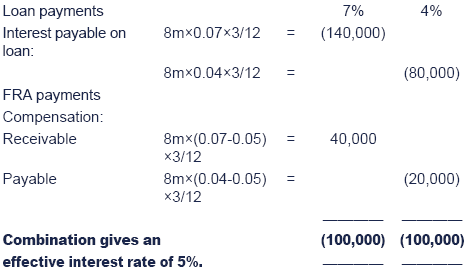
- In this case the company is protected from a rise in interest rates but is not able to benefit from a fall in interest rates – a FRA hedges the company against both an adverse movement and a favourable movement.
- The FRA is a totally separate contractual agreement from the loan itself and could be arranged with a completely different bank.
- FRAs are usually on amounts > $1m and enable you to hedge for a period of one month up to two years. However, as an ‘over the counter’ instrument, they can be tailor-made to the company’s precise requirements.


 Settlement payment on an FRA
Settlement payment on an FRA
Because the settlement payment is made at the start of the loan/deposit period, the actual payment made is the present value of the interest differential at that date, discounted using the market reference interest rate.
Illustration
Using the details for the Enfield Inc example above with a 7% market rate:
- The difference in interest rates gave rise to a potential receipt of $40,000 from the bank.
- The actual amount received will be 40,000/(1 + 0.07 × 3/12) = $39,312.
- One approach is to use this to reduce the loan from $8 million to $7,960,688. If this sum is then borrowed at 7% for 3 months, then the final repayment will be:
7,960,688 × (1 + 0.07×3/12) = 8,100,000
This gives an effective interest rate of $100,000 on $8m, or 5%.

3 Options on FRAs
Interest rate guarantees (options on FRAs)
- An interest rate guarantee (IRG) is an option on an FRA and, like all options, protects the company from adverse movements and allows it take advantage of favourable movements.
- If borrowing money, a firm would buy an FRA (explained above), so a call option over FRAs would be used. Similarly a put option over FRAs would be used to cover a deposit.
- IRGs are usually written by banks and other financial houses (i.e. the same organisations that may offer FRAs).
Decision rules

- IRGs are more expensive than the FRAs as one has to pay for the flexibility to be able to take advantage of a favourable movement.

 Illustration 2: IRG
Illustration 2: IRG
Harry Inc wishes to borrow $8m in two months’ time for a period of three months.
An IRG is available at 5% for a premium of 0.1% of the size of the loan.
Calculate the interest payable if in two months' time the market rate is:
(a) 7% or (b) 4%.
Solution
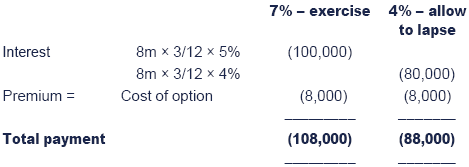
Note: There is no need to time apportion the premium percentage.


 Test your understanding 1
Test your understanding 1
RGI Co wishes to invest $12 million in 6 months' time for two months and considering the following hedging strategies.
(1)A 6–8 FRA quoted at 4%.
(2)An IRG at 4% for a premium of 0.1%.
Determine the costs if in six months time the market rate is: (a) 5% (b) 3% and comment.

When to hedge using FRAs or IRGs
- If the company treasurer believes that interest rates will rise, will he use an FRA or an IRG? He will use an FRA, as it is the cheaper way to hedge against the potential adverse movement.
- If the treasurer is unsure which way interest rates will move he may be willing to use the more expensive IRG to be able to benefit from a potential fall in interest rates.
4 Interest rate futures (IRFs)
Introduction
Types of IRFs
There are two broad types of interest rate futures:
- Short-term interest rate futures (STIRs). These are standardised exchange-traded forward contracts on a notional deposit (usually a three-month deposit) of a standard amount of principal, starting on the contract’s final settlement date.
- Bond futures. These are contracts on a standard quantity of notional government bonds. If they reach final settlement date, and a buyer or seller does not close his position before then, the contracts must be settled by physical delivery.
Underlying assets
To understand whether you need to buy or sell contracts, interestrate futures are best understood as involving the sale or purchase ofbonds.
- borrowing money equates to issuing (selling) bonds, so sell futures to set up the hedge.
- depositing funds equates to buying bonds, so buy futures to set up the hedge
Futures hedging calculations
Step 1: Set up the hedge by addressing 3 key questions:
- Do we initially buy or sell futures?
- How many contracts?
- Which expiry date should be chosen?
Step 2: Contact the exchange. Pay the initial margin. Then wait until the transaction / settlement date.
Step 3: Calculate profit or loss in the futures market by closingout the futures contracts, and calculate the value of the transactionusing the market rate of interest rate on the transaction date.
Calculations – particular characteristics of IRFs
Ticks and tick values
- For STIRs, the minimum price movement is usually 0.01% or one basis point. The value of a tick is calculated as follows:
- Tick value = unit of trading (i.e amount of principal) × one basis point × fraction of year.
- For three-month sterling (‘short sterling’) futures, the underlying deposit for one contract is £500,000, so the value of one tick is £500,000 × 0.0001 × 3/12 = £12.50.
Futures prices
- Interest rate futures prices are stated as (100 – the expected market reference rate), so a price of 95.5 would imply an interest rate of 4.5%.
- Open and settlement prices - in an exam question, when setting up the hedge, you may be quoted "Open" and "Settlement" futures prices. When setting up the hedge, the "Settlement" price should be used - the "Open" price is not relevant in our calculations.
Calculating the number of contracts needed


 More practical information on IRFs
More practical information on IRFs
Contract specifications
Short-term interest rate futures are traded on a number of futures exchanges. For example:
- STIRs for sterling (three-month LIBOR) and the euro (three-month euribor) are traded on Euronext.liffe (formerly LIFFE), the London futures exchange.
- A STIR contract for the US dollar (eurodollar) is traded on the Chicago Mercantile Exchange (CME).
Here are just a few STIR contract specifications.
Short-term interest rate futures

Tick values
- For three-month sterling (‘short sterling’ futures), the underlying deposit is £500,000, so the value of one tick is £500,000 × 3/12 × 0.0001 = £12.50.
- For three-month euribor futures, the underlying deposit is €1,000,000, so the value of one tick is €1,000,000 × 3/12 × 0.0001 = €25.
- For three-month eurodollar futures, the underlying deposit is $1,000,000, so the value of one tick is $1,000,000 × 3/12 × 0.0001 = $25.
Note: For three-month euroyen futures, the underlyingdeposit is ¥100 m but the tick size is 0.005%, so the value of one tickis ¥100 million × 3/12 × 0.00005 = ¥1250.


 Illustration 3: IRF
Illustration 3: IRF
Global Inc wishes to borrow €9,000,000 for one month starting in 5weeks’ time. Euribor is currently 3% and the treasurer of Globaldecides to fix the rate by selling IRFs at 96.90. The market ratesubsequently rises by 25 basis points to 3.25%. As soon as the loan isagreed, the treasurer closes out Global’s position by buying amatching number of contracts at 96.65.
(a) Calculate the number of contracts required (Note: one 3-month contract is for €1,000,000)
(b) Demonstrate that, in this case, the gain on the futures contracts exactly matches the extra interest on the loan.
Solution
(a) Number of contracts = (9,000,000/1,000,000 ) × 1/3 = 3
(b) Extra interest cost on loan = 0.25% × 9,000,000 × 1/12 = €1,875
Gain on futures = 3 contracts × 25 ticks per contract × €25 per tick (W) = €1,875
(W: value of tick = €1,000,000 × 3/12 × 0.0001 = €25)

 Test your understanding 2
Test your understanding 2
Assume that today is the 25th of January.
A company is going to borrow $2,000,000 in two months' time for aperiod of three months. It fears that the current interest rate willrise from its current level of 5%, so it wants to use $500,000 3-monthinterest rate futures to hedge the position.
Data from the futures market:
March futures price = 94.90
June futures price = 94.65
Required:
Calculate the result of the relevant futures hedge on theassumption that interest rates have risen to 7% and the futures pricehas moved to 92.90 in two months' time.

Imperfect hedges
The futures hedge is imperfect due to:
- If you are not dealing in whole contracts and have to round to whole contracts.
- Basis risk – the future rate (as defined by the future prices) moves approximately but not precisely in line with the cash market rate. An understanding of basis risk can help to predict the closing futures price if you are not given the necessary information in a question.

 Illustration 4: Basis calculation
Illustration 4: Basis calculation
Sopoph Co is using June interest rate futures to cover the interest rate risk on a borrowing starting on 31 May.
At the time the futures contracts were set up on 1 January, the LIBOR rate was 5.00% and the futures price was 95.48.
LIBOR on 31 May is predicted to be 4.00%.
Estimate the closing futures price on 31 May, assuming that basis risk reduces in a linear manner.
Solution

(W1) Basis will reduce to zero by the expiry date of thecontract, because on that date, the futures price will equal 100 - the(known) LIBOR rate.
(W2) Assuming basis reduces in a linear manner, the basis at 31 May should be 1/6 of the original 0.48% i.e. 0.08%.
(W3) Basis is the difference between LIBOR and the impliedfutures price interest rate, so implied interest rate is 4.00% - 0.08% =3.92% and futures price is 96.08.

5 Options on interest rate futures
Options on futures
- These are options to buy or sell futures. Therefore all the futures information is still valid, for example:
- The standard size of the contracts, i.e. £500,000, $1,000,000 etc.
- The duration of the contract, i.e. 3 month contracts.
- The appropriate tick value, i.e. £12.50, $25.00.
- Maturity dates end of March, June, September and December.
- A call option gives the holder the right to buy the futures contract.
- A put option gives the holder the right to sell the futures contract.
- You always buy the option – buy the right to buy or buy the right to sell.

Exercise prices and premium costs
- When you are setting up the hedge position for an option you have a number of prices (exercise prices) from which to choose (as opposed to the futures position where you buy or sell at the current price).

 Illustration 5: Option prices
Illustration 5: Option prices
Euronext.liffe option price on three-month Sterling December futures

- If a company had a deposit of £500,000 and the treasurer wanted to hedge the position using traded options, he would buy a call option. If he purchased it at an exercise price of 95.00 he would be buying the right to interest receipts at 5% this would cost him a premium 0.87% (i.e. 0.87% × 100) 87 ticks (i.e. 87 × £12.50) = £1,088 per contract.
- If he purchased it at 93.50 he would be buying the right to interest receipts at 6.50% this would cost him a premium 2.20% (i.e. 2.20% × 100) 220 ticks (i.e. 220 × £12.50) = £2,750 per contract.
- The premium cost of the option will obviously depend on the exercise price chosen. Buying a call option at 93.50 should be more expensive than buying at 95.00, as the company has a greater chance of a profit when it comes to closing out its futures position.

Choosing an exercise price
There are various ways of choosing an exercise price.
- NB: In a question, you may be told which exercise price to use, so check that first.
- One common way is to choose the exercise price closest to the current interest rate, so if the current interest rate were 6.00% then an exercise price of 94.00 would be chosen.
- Alternatively, if we assume that the options are to be exercised then the way to find the exercise price that will result in the highest net receipt and minimum total interest payment is as follows:

 Illustration 6: Option prices (continued)
Illustration 6: Option prices (continued)
CALL OPTIONS – deposit – highest net receipt.
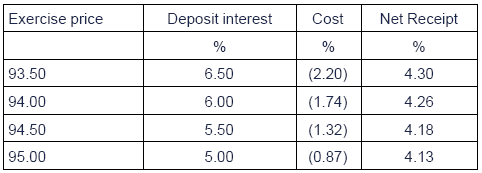
PUT OPTIONS – loan – lowest total payment


Options hedging calculations
Step 1: Set up the hedge by addressing 4 key questions:
- Do we need call or put options?
- How many contracts?
- Which expiry date should be chosen?
- Which strike price / exercise price should be used?
Step 2: Contact the exchange. Pay the upfront premium. Then wait until the transaction / settlement date.
Step 3: On the transaction date, compare the option price with theprevailing market interest rate to determine whether the option shouldbe exercised or allowed to lapse.
Step 4: Calculate the net cash flows - beware that if the number ofcontracts needed rounding, there will be some borrowing or deposit atthe prevailing market interest rate even if the option is exercised.
Decision point – exercise the option or allow it to lapse
General rule:
Double check:
- Would you ever exercise an option that results in a loss?
- Therefore you must always have a profit on the futures when exercising and a potential loss if you allow the option to lapse.

 Test your understanding 3: Interest rate options
Test your understanding 3: Interest rate options
It is now the 31st of July.
Tolhurst Co needs to borrow $10m in 1 month's time, for a 6 month period. The current market interest rate is 5%.
The following information is available regarding $500,000 3-month September interest rate options:

Premia are quoted in %.
Required:
Calculate the result of the options hedge if the interest rate hasrisen to 7.5% and if the September futures price has moved to 93.00 inone month's time.

Options terminology: Caps and floors
Caps
We have seen above that a borrower will hedge against the risk ofinterest rate rises by buying a put option over interest rate futures.
A cap is another name for this put option over interest rate futures.
Floors
Similarly, a depositer will hedge against the risk of interest rate falls by buying a call option over interest rate futures.
Such an option can also be called a floor.
Options terminology: Collars
- A company buys an option to protect against an adverse movement whilst allowing it to take advantage of a favourable movement in interest rates. The option will be more expensive than a futures hedge. The company must pay for the flexibility to take advantage of a favourable movement.
- A collar is a way of achieving some flexibility at a lower cost than a straight option.
- Under a collar arrangement the company limits its ability to take advantage of a favourable movement.
- For example, for a borrower, it buys a cap (a put option) as normal but also sells a floor (a call option) on the same futures contract, but with a different exercise price.
- The floor sets a minimum cost for the company. The counterparty is willing to pay the company for this guarantee of a minimum income. Thus the company gets paid for limiting its ability to take advance of a favourable movement if the interest rate falls below the floor rate the company does not benefit therefore the counterparty does.
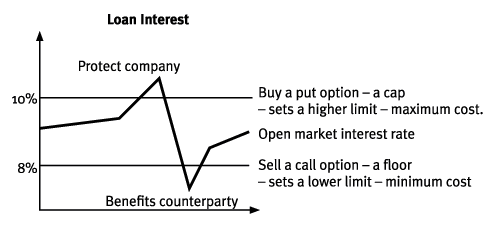
- It involves a company arranging both a minimum and a maximum limit on its interest rates payments or receipts. It enables a company to convert a floating rate of interest into a semi-fixed rate of interest.

 Test your understanding 4
Test your understanding 4
A company wishes to borrow £10m on the 1st of January for threemonths. The company does not wish to pay above its current rate of 10%.The company borrows at LIBOR + a fixed margin of 2% (therefore it willbuy a put at 92.00 to ensure a maximum company cost of 10%). LIBOR iscurrently 8%.
Having made initial enquiries, it has been discouraged by the costsof the option. A member of its treasury team has suggested the use of acollar to reduce the premium cost of the purchased option. The companybelieves that LIBOR will not fall below 5.5% (therefore it will sell acall at 94.50 to ensure a minimum cost of 5.5%).

Calculate the effective interest rate the company will pay using a collar if:
(a) LIBOR rises to 9.5% and future prices move to 90.20.
(b) LIBOR falls to 4.5% and future prices move to 96.10.

6 Interest rate swaps
Introduction
An interest rate swap is an agreement whereby the parties agree toswap a floating stream of interest payments for a fixed stream ofinterest payments and via versa. There is no exchange of principal:
- The companies involved are termed ‘counter-parties’.
- Swaps can run for up to 30 years.
- Swaps can be used to hedge against an adverse movement in interest rates. Say a company has a $200m floating loan and the treasurer believes that interest rates are likely to rise over the next five years. He could enter into a five-year swap with a counter party to swap into a fixed rate of interest for the next five years. From year six onwards, the company will once again pay a floating rate of interest.
- A swap can be used to obtain cheaper finance. A swap should result in a company being able to borrow what they want at a better rate under a swap arrangement, than borrowing it directly themselves.
Calculations based on splitting gains
- The precise details of the swap arrangement will depend on how the potential gains are split between the two counter-parties.

 Illustration 7: Interest rate swap
Illustration 7: Interest rate swap
Company A wishes to raise $10m and to pay interest at a floatingrate, as it would like to be able to take advantage of any fall ininterest rates. It can borrow for one year at a fixed rate of 10% or at afloating rate of 1% above LIBOR.
Company B also wishes to raise $10m. They would prefer to issuefixed rate debt because they want certainty about their future interestpayments, but can only borrow for one year at 13% fixed or LIBOR + 2%floating, as it has a lower credit rating than company A.
Calculate the effective swap rate for each company – assume savings are split equally.
Solution
Step 1: Identify the type of loan with the biggest difference in rates.
Step 2: Identify the party that can borrow this type of loan the cheapest.
- Answer: Company A
- Thus Company A should borrow fixed, company B variable, reflecting their comparative advantages.
Step 3:
- Company A has cheaper borrowing in both fixed and variable. Interest rate differentials are 3% for fixed and 1% for variable. The difference between these (2%) is the potential gain from the swap.
- Splitting this equally between the two counter parties, each should gain by 1%.
One way (there are many!) of achieving this is for A to pay B LIBOR (variable) and for B to pay A 10%.
Summary



 Test your understanding 5
Test your understanding 5
Company X also wishes to raise $50m. They would prefer to issue fixedrate debt and can borrow for one year at 6% fixed or LIBOR + 80 points.
Company Y also wishes to raise $50m and to pay interest at afloating rate. It can borrow for one year at a fixed rate of 5% or atLIBOR + 50 points.
Calculate the effective swap rate for each company – assume savings are split equally.

Calculations involving quoted rates from intermediaries
In practice a bank normally arranges the swap and will quote the following:
- The ‘ask rate’ at which the bank is willing to receive a fixed interest cash flow stream in exchange for paying LIBOR.
- The ‘bid rate’ that they are willing to pay in exchange for receiving LIBOR.
- The difference between these gives the bank’s profit margin and is usually at least 2 basis points.
Note: LIBOR is the most widely used benchmark or referencerate for short-term interest rates worldwide, although the swap couldrelate to Euribor, say.

 Illustration 8: Interest rate swap via an intermediary
Illustration 8: Interest rate swap via an intermediary
Co A currently has a 12-month loan at a fixed rate of 5% but wouldlike to swap to variable. It can currently borrow at a variable rate ofLIBOR + 12 basis points.
The bank is currently quoting 12-month swap rates of 4.90 (bid) and 4.95 (ask).
Show Co A's financial position if it enters the swap.
Solution
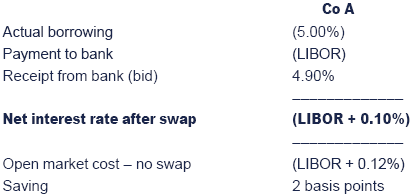


 Test your understanding 6
Test your understanding 6
Co B has a 12-month loan at a variable rate of LIBOR + 15 basispoints but, due to fears over interest rate rises, would like to swap toa fixed rate. It can currently borrow at 5.12% fixed.
The bank is currently quoting 12-month swap rates of 4.90 (bid) and4.95 (ask). Assume this is the same bank as in the previousillustration.
Show Co B's financial position if it enters the swap.Comment on the bank's position, bearing in mind the positions of Co A(in the previous Illustration) and Co B.


 Further swap example
Further swap example
Company A has a 12 month loan at a variable rate of LIBOR + 50basis points but, due to fears over interest rate rises, would like toswap to a fixed rate. It can currently borrow at 5.40% fixed.
Company B currently has a 12 month loan at a fixed rate of 4.85%but would like to swap to variable. It can currently borrow at avariable rate of LIBOR + 65 basis points.
The bank is currently quoting 12 month swap rates of 4.50 (bid) and 4.52 (ask).
Show how the swap via the intermediary would work.
Solution
- Co A already has a variable outflow so must receive LIBOR from the bank to convert this to fixed. It will pay the bank the ask rate.
- Similarly Co B must pay the bank variable and receive fixed at the bid rate.
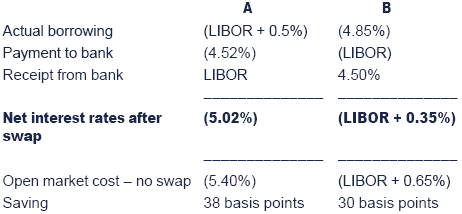
Note: In this case A can borrow variable cheaper but B canget the best fixed rates. In this case the total potential saving = Dfixed + D variable = 55 + 15 = 70 basis points.
Of this, 2 basis points have gone to the bank via the spread inquoted prices, leaving 68 to be shared between the two companies.


 Options over swaps
Options over swaps
- Swaptions are hybrid derivative products that integrate the benefits of swaps and options. They are options on swaps.
- The purchaser of an interest rate swaption has the right, but not the obligation, to enter into an interest rate swap at some future date on terms agreed today. An up front premium is payable.
Swaption illustration
Shun Inc has a $10m loan, repayable in 5 years, at LIBOR + 2%.LIBOR is currently at 5.75%. The company is thus exposed to the risk offluctuating interest rates.
The treasurer believes that LIBOR will stay low for the next twoyears, after which period, however, the outlook is at best uncertain.She would like to hedge this risk but is not sure if the current swaprate is the best available. The treasurer wants to lock in the swap ratein two years time for the following three years and have theflexibility to benefit from a lower swap rate should swap rates fall.
This is achieved by buying a 2-year option on a 3-year pay fixed 7%swap. The decision that will have to be made in two years isillustrated below:


7 Chapter summary
Summary of terminology

Test your understanding answers

 Test your understanding 1
Test your understanding 1

Comment: the choice between FRA and IRG will depend on expectations and the desired risk exposure of the firm.


 Test your understanding 2
Test your understanding 2
- Buy or sell futures? Sell, since we are borrowing
- Number of contracts = (2,000,000/500,000) × 3/3 = 4
- Which expiry date? March, since it expires soonest after the transaction date of 25 March.
Contact the exchange: We need to sell 4 March contracts at a price of 94.90
Two months later:
Transaction: Interest will be $2m × 3/12 × 7%
= $35,000
Futures market:
- Number of ticks movement per contract = (94.90 - 92.90) × 100 = 200
- Value of a tick = £500,000 × 3/12 × 0.0001 = £12.50
- Profit on futures = ticks per contract × tick value × no of contracts = 200 × 12.50 × 4 = £10,000
Hence, net cost = $35,000 - $10,000 = $25,000


 Test your understanding 3: Interest rate options
Test your understanding 3: Interest rate options
Set up hedge:
- Call or put options? Put here, to cover a borrowing.
- How many contracts? ($10m / $500k ) × (6/3) = 40
- Expiry date? September - expires soonest after the transaction date of 31 August.
- Which exercise price?

So we can see that the 94.75 option is the cheapest total cost.
Contact exchange: We need to buy 40 September put options with an exercise price of 94.75.
Premium payable upfront = 0.18% × 40 × $500,000 × 3/12 = $9,000
1 month later:
Transaction: Interest = 7.5% × $10m × 6/12 = $375,000
Futures/options market:
Exercise the put option i.e sell at 94.75
Close out: Buy at futures price of 93.00
Gain is 1.75% (175 ticks) × 40 × $500,000 × 3/12 = $87,500
So, the net interest cost is $375,000 - $87,500 = $287,500 (less the initial premium of $9,000)


 Test your understanding 4
Test your understanding 4

(a) Interest rates exceed the capso the company will exercise its put option: (9.5%) + (2%) + (-0.20 +0.15) + 92.00 – 90.20 = (9.75%).
(b) Interest rates have fallenbelow the floor so the bank will exercise its call option: (4.5%) + (2%)+ (-0.20 + 0.15) – 96.10 + 94.50 = (8.15%).


 Test your understanding 5
Test your understanding 5
Step 1: Identify the type of loan with the biggest difference in rates.
Step 2: Identify the party that can borrow this type of loan the cheapest.
- Answer: Company Y should borrow fixed, company X variable.
Step 3: Split gains.
- Company Y has cheaper borrowing in both fixed and variable. Interest rate differentials are 1% for fixed and 0.3% for variable. The difference between these (70 basis points) is the potential gain from the swap.
- Splitting this equally between the two counter parties, each should gain by 35 basis points.
- One way of achieving this is for X to pay Y 4.85% and for Y to pay X LIBOR (variable).
Summary



 Test your understanding 6
Test your understanding 6

Both Co A and Co B have saved 2 basis points by entering their swaps.
The bank has made a profit of 5 basis points - the difference between the bid and ask rates:

|
Created at 5/24/2012 3:58 PM by System Account
(GMT) Greenwich Mean Time : Dublin, Edinburgh, Lisbon, London
|
Last modified at 5/25/2012 12:55 PM by System Account
(GMT) Greenwich Mean Time : Dublin, Edinburgh, Lisbon, London
|
|
|
|
 |
Rating
:
|
 Ratings & Comments
(Click the stars to rate the page) Ratings & Comments
(Click the stars to rate the page)
|
 |
Tags:
|
|
|
|
|